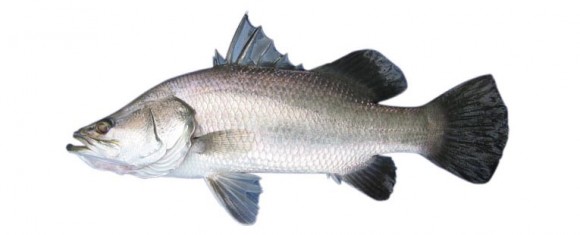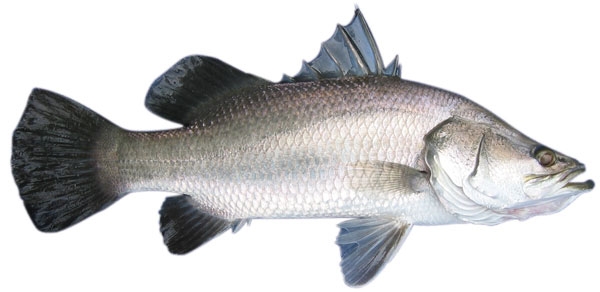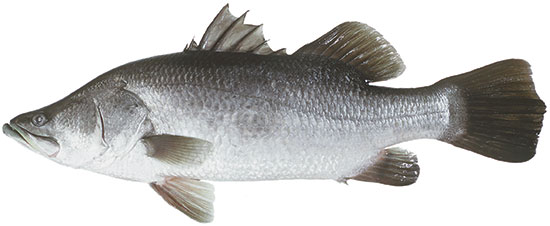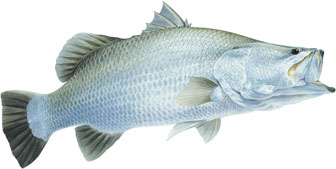
Lates calcarifer
FAMILY
Centropomidae
TAXONOMY
Lates calcarifer Bloch, 1790, Japan.
OTHER COMMON NAMES
English: Asian seabass, Barramundi perch; French: Brochet de
mer.
PHYSICAL CHARACTERISTICS
Total length 79 in (200 cm). Body large, elongate, and stout,
with pronounced concave dorsal profile in head and a prominent
snout. Color silvery but may be greenish or bluish gray
on dorsal surfaces. Fins blackish or dusky brown. Juveniles
have mottled pattern of brown with three white stripes on
head and nape, and white blotches irregularly placed on back.
There are 8–9 spines and 10–11 soft rays in the dorsal fin, 3
spines and 7–8 soft rays in the anal fin, and 7–8 soft rays in the
pectoral fin. Caudal fin is truncate.
DISTRIBUTION
Indo-West Pacific from East Africa through tropical and warm
temperate Asia, including southern Japan, south through Indonesia
to northern Australia (from Shark Bay north in Western
Australia, and the Mary River in southern Queensland in the
east). Insular localities must have sufficient stream development.
HABITAT
Rivers and larger streams, billabongs, submerged floodplains,
estuaries, and coastal waters. Juveniles migrate from the ocean
upstream to the upper reaches of rivers and creeks where they
shelter in vegetation, undercut banks, and other forms of structure.
Adults tend to be found in lower reaches of turbid rivers
and utilize holes or structure, such as submerged timber, rocks,
and mangroves.
BEHAVIOR
Adults and juveniles tend to be solitary, patrol home ranges
near structure, and may be territorial. Migration is seasonal.
FEEDING ECOLOGY AND DIET
Voracious predator of fishes and crustaceans. Juveniles also
feed on insects. Skilled at stalking or ambushing prey.
REPRODUCTIVE BIOLOGY
Catadromous. Migrates downstream to shallow mudflats in estuaries
during the wet season. Spawning occurs between September
and March in Australia, with peaks in November to
December and again in February to March. Females are larger
than males, are highly fecund, and may be courted by one or
more males at the same time. Eggs are pelagic, hatch within 24
hours, and the larvae grow quickly as they move into mangrove
areas, mudflats, and floodplain lagoons. Juveniles move into
coastal waters after one year, then migrate upstream where
adults reside for three to four years. Populations landlocked by
dams migrate to the dam face, but do not spawn. Raised extensively
by aquaculture as food or for game fish-stocking programs.
CONSERVATION STATUS
Not listed by the IUCN, but has been threatened by
HABITAT
destruction and overfishing.
SIGNIFICANCE TO HUMANS
Important as a commercial and subsistence food fish but also as
a game fish. The most important commercial fish of Australia,
and the most sought after game fish, generates millions of dollars
per year in revenue for the sportfishing and tourist industries.
Cultured fish are replacing wild-caught fishes as food in
parts of Australia where netting is banned. Also important in
the cultures of aboriginal Australians.
Other popular Animals
Photo Gallery of - Barramundi





 Animalia Life
Animalia Life